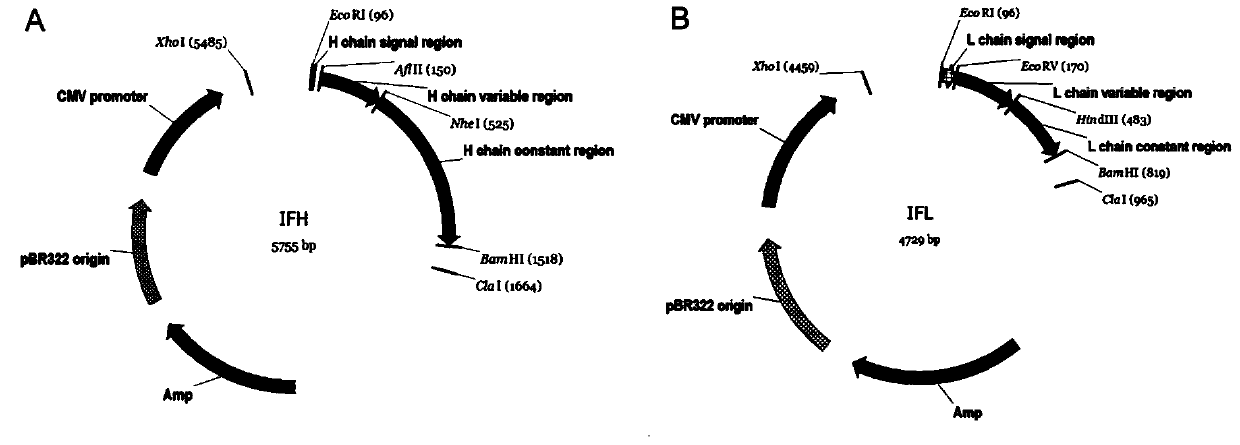Humanized antibody for resisting avian influenza H5N1 hemagglutinin antigen, and preparation method and application thereof
A humanized antibody and avian influenza technology, applied in the biological field, can solve problems such as time-consuming transformation, reduced affinity activity, and other problems, and achieve the effect of reducing immunogenicity, high neutralization activity, and wide application prospects
- Summary
- Abstract
- Description
- Claims
- Application Information
AI Technical Summary
Problems solved by technology
Method used
Image
Examples
Embodiment 1
[0046] Example 1. Humanized transformation of murine antibody mH5M9
[0047] The variable region sequence of the murine antibody mH5M9 is published in the NCBI database (heavy chain GenBank No.AGX28126.1, light chain GenBank No.AGX28125.1), see figure 1 . Use the Kabat method to find out the CDR sequence, see figure 1 underlined part. The murine antibody mH5M9 was humanized by CDR grafting. The most suitable template was searched by BLASTP-search against the non-redundant protein database, and the results showed that the heavy and light chains of human anti-FabOX108 (PDB No.3DGG_B and No.3DGG_A) had the highest homology, reaching 73% and 75%. Then, the heavy chain and light chain CDR regions of the murine antibody mH5M9 were grafted onto the FR frameworks of the human templates VH and VL, respectively, to obtain the original humanized antibody A1. For the sequence comparison results, see figure 2 .
[0048] Based on the simulated spatial structure of the initial version ...
Embodiment 2
[0051] Example 2. Construction of humanized antibody expression vector
[0052] Insert the humanized antibody hH5M9 heavy and light chain variable region genes (SEQ ID NO: 3 and SEQ ID NO: 4) into the corresponding sites of the eukaryotic expression vector to obtain positive recombinant plasmids IFH-VH and IFL -VL, the expression vector is preserved by our laboratory. Expression vector plasmid map such as image 3 Shown, wherein, A is the heavy chain eukaryotic expression vector IFH; B is the light chain eukaryotic expression vector IFL.
Embodiment 3
[0053] Example 3. Expression of Humanized Antibodies
[0054] The humanized antibody expression vectors IFH-VH and IFH-VL constructed in the above Example 2 were transformed into Escherichia coli DH5α, and positive clones were picked and inoculated in 500ml LB medium for amplification. Using the plasmid extraction kit from MACHEREY-NAGEL Xtra Mid), the DNA was extracted and purified according to the manufacturer's instructions. Using Invitrogen's FreeStyle TM MAX Reagent transfection The above plasmid DNA was co-transfected into 293F cells (host cell 293F cells, purchased from Invitrogen), and the operation method was performed according to the manufacturer's instructions. Culture supernatants were collected 6-7 days after transfection.
PUM
 Login to View More
Login to View More Abstract
Description
Claims
Application Information
 Login to View More
Login to View More - Generate Ideas
- Intellectual Property
- Life Sciences
- Materials
- Tech Scout
- Unparalleled Data Quality
- Higher Quality Content
- 60% Fewer Hallucinations
Browse by: Latest US Patents, China's latest patents, Technical Efficacy Thesaurus, Application Domain, Technology Topic, Popular Technical Reports.
© 2025 PatSnap. All rights reserved.Legal|Privacy policy|Modern Slavery Act Transparency Statement|Sitemap|About US| Contact US: help@patsnap.com



